As NE 65th Street safety changes develop, tell SDOT to keep sidewalks wide and bike lanes protected
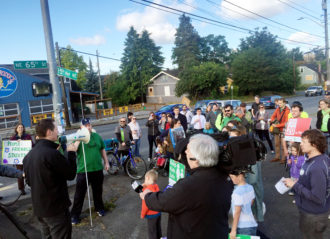
Councilmember Rob Johnson addresses a neighborhood march demanding a safer NE 65th Street in June 2016.
NE 65th Street needs a safer design. People keep getting seriously injured and killed on this street, and that won't stop until something changes. This point has been well established, with neighbors even leading a community memorial and march to protest the dangerous conditions and demand action from the city.
Councilmember Rob Johnson, whose District includes this street, joined the march and made funding a safety project there a priority. And he backed his words up with budget action.
NE 65th is set to get a lot safer and more comfortable in summer 2018, and that's very exciting.
So now, the question isn't whether the street needs safety changes, including protected bike lanes. If you want to know more about that, read our previous posts on the subject. Now the question is what those changes should look like, and judging by in-development design documents, the project needs some reworking to make sure sidewalks remain wide enough and the bike lanes get enough protection at intersections.
You can get an updated look at the design and provide feedback in person at two public drop-in sessions 5-7 p.m. today (Tuesday) and 7-9 a.m. Thursday at Broadcast Coffee. You can also send comments to NE65VisionZero@seattle.gov.
The worry, shared by many neighborhood safe streets advocates including NE Seattle Greenways' Andres Salomon, is that many design details prioritize moving cars over safety. Salomon, who has been advocating around NE 65th Street for years, even put together detailed comments on his concerns (PDF). While the design includes bike lanes, thanks to strong neighborhood organizing and support from Councilmember Johnson, many other details chip away at the safety benefits in an attempt to prevent car delay.
Perhaps the best illustration of this is the proposed design for bus stop islands. Because the bike lane is protected, bus stops need to be constructed that allow people biking to pass safety behind the loading area without needing to merge back into car traffic. These islands have become familiar around Seattle ever since the city constructed a bunch of them along Dexter Ave in 2011. When designed well, they work well for everyone.
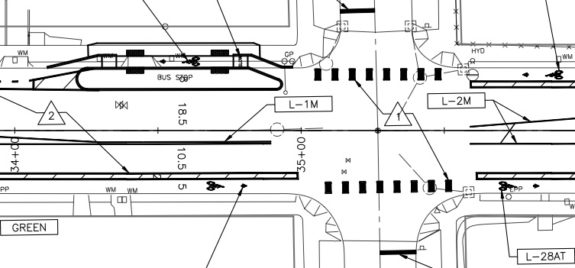
Example of a bus island from SDOT's 60 percent design document dated November 2017 (PDF.
The problem with the in-development NE 65th Street bus stops is that instead of having buses stop in-lane, the design takes space away from the sidewalk so that people driving have a 15-foot lane with enough space to pass loading buses. The result is that both the sidewalk and bike lane will only be a substandard four feet wide as they pass behind the bus stop. Four feet is not enough space for two people to comfortably walk past each other, and it's definitely not a comfortable amount of space for people who use mobility devices who can't easily turn sideways to squeeze past someone else.
As the Urbanist points out, Seattle's own right of way guidelines suggest eight feet as a minimum in designated pedestrian zones, such as commercial streets near light rail stations. This design would be half that.
In plain speak, SDOT designers are taking space from people walking so that people driving don't need to wait a few seconds while a bus loads and unloads in instances where they happen to be following a bus. This is all wrong, especially for a street that is about to get a light rail station and see big increases in housing and foot traffic.
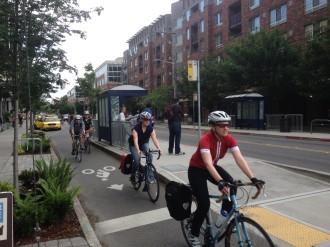
A transit island on Dexter.
In-lane bus stops are great, and Seattle has several great examples of how they work in practice. In fact, our city is a national leader in innovating in-lane bus stops that work, and SDOT should be proud of that.
Dexter is one great example. But perhaps a more relevant example is Wallingford's N/NE 45th Street, which is a similar east-west commercial street with much higher traffic volumes than NE 65th Street. Though there are no bike lanes on 45th, but SDOT installed a bunch of expanded bus stops a few years back to help speed up Route 44. The improved bus stops even include center islands to prevent people from driving in the turn lane to illegally pass a stopped bus. It works so well, the National Association of City Transportation Officials even included it (and Dexter) in their Transit Street Design Guide:
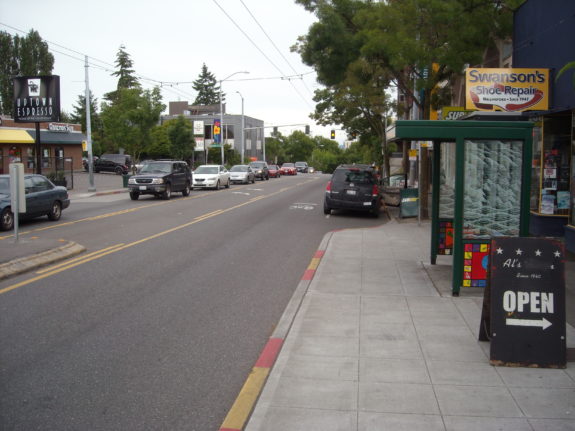
SDOT photo included in the NACTO Transit Street Design Guide shows a well-functioning in-lane bus stop.
If SDOT really considers safety to be its top priority, as staff and political leader always say, and believe that walking, biking and transit are the sustainable transportation modes that will best absorb trips as our city grows, then there is no excuse for taking space from the sidewalk so that people driving can go around a bus every once in a while and shave a few seconds. SDOT has inspired the nation with its bus stop innovations, and the department should be proud and look for ways to innovate even further to make NE 65th Street the new best example of what a safe, multimodal street really looks like.
There are a couple other vital details the project team needs to improve. The intersections are lacking any element of a protected intersection design, which seems like another missed opportunity for innovation. Perhaps there are budget constraints, but this project includes two intersections with existing protected bike lanes (Ravenna Blvd and Roosevelt Way). It's disappointing to see the department not even trying to innovate around those opportunities to make safer crossings and connections for the growing bike network.
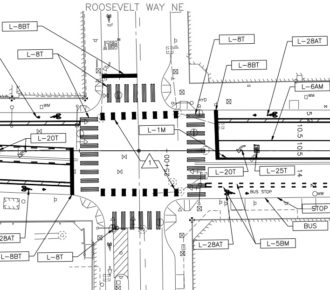
The dashed line shows where buses would stop in the bike lane.
Perhaps more worrying, though, is that two bus stops near Roosevelt and 12th Ave NE will actually stop in the bike lane. This means people biking behind a bus will be faced with a set of bad options:
- Stop behind the bus, perhaps hanging out in the intersection
- Ride on the sidewalk in a busy commercial area
- Merge with car traffic to pass the bus, which could pull away from the stop at any moment
A bike route is only as comfortable as its least comfortable section, and this will be it. The lack of a bus island in this area is to preserve a turn lane. So, again, it's a decision to prioritize car traffic over safety. And because the bike lane won't be protected, you can expect people to illegally park in the bus stop/bike lane area quite often, whether to drop off passengers or make deliveries or run in to a store "for just a second."
The NE 65th Street bike lanes are going to be amazing for the city's bike network and for improving safety in this growing and increasingly vibrant business district. SDOT should go for the grand slam here and do it right.